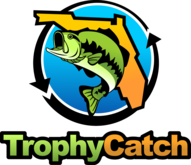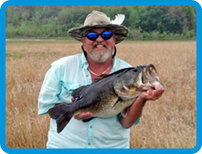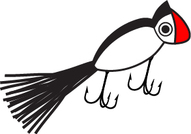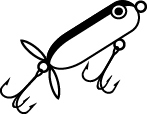 TrophyCatch is well into its fourth season! Here is the tally as of March and submissions are up from this time last year. If you haven't registered yet there's no better time, and registering for TrophyCatch is free and makes you eligible for the Phoenix Boat bass boat giveaway next October!
-- 859 Lunker Club bass (8 - 9.9 lbs)
-- 172 Trophy Club bass (10 - 12.9 lbs)
-- 5 Hall of Fame bass (13+ lbs)
-- Check out the Gallery of Catches at TrophyCatchFlorida.com
■ Thanks to Bass Pro Shops, Phoenix Boats, Mercury Marine, Rapala, SpiderWire, Power-Pole, American Outdoors Fund and our other partners for their tremendous support for this exciting conservation program!
|
 |
|
The current leader is Paul Desrosier with a 14-pound, 10-ounce bass that
was caught and released on March 13 in Jessamine Lake, Pasco County. With a
good portion of the spawn -- and the year's best bass fishing -- still
to come, we'll be watching closely to see if this changes. Good luck to Paul and all of our other participants! |
|
Here's a peek at Season 4's Phoenix Boats TrophyCatch bass boat! Registering
For TrophyCatch automatically enters you in the free boat drawing, and
you get an additional 10 chances for each TrophyCatch bass you
successfully submit!
|
|
 |
 Size: The state record is 44.50 lbs. The Big Catch minimum qualifying sizes are 25 inches or 12.0 pounds for adults, and 19 inches or 9.0 pounds for youth (BigCatchFlorida.com).
Identification and similar species: Channel catfish are easy to distinguish by their deeply forked tail and rounded anal fin. Channels have scattered
black spots along their back and sides, which distinguish them from the blue catfish, and
like all catfish they have sensory barbels that look like cat whiskers.
|
Angling qualities: Catfish are a staple for anglers who like to keep and eat their catch. Catfish have an excellent sense of smell, so use baits with a
strong scent such as chicken liver or gizzards, shrimp, cut mullet and
commercial stinkbaits. Catfish are most active just before dusk and at
night. Fish on the bottom with a sturdy #2 to 1/0 hook, depending on the size of the local catfish population, and use just enough weight to keep the bait on the bottom if there is current. Be careful of sharp spines when handling these fish. Primarily bottom feeders, channels also feed higher up in the water column. Bigger catfish in particular tend to become more piscivorous (eating other fish) as they grow larger. The FWC stocks 200,000-300,000 channel catfish annually in public waters (see stocking website).
Where to catch them: Channel catfish are common throughout Florida, but some of the state's Top Spots include the Apalachicola River, Choctawhatchee River, Escambia River, Upper and Lower St. Johns River, Ochlockonee River, the upper Kissimmee Chain of Lakes, Mosaic Fish Management Area, and Medard Reservoir.
New black bass rules are in effect throughout Florida, beginning July 1, 2016 to streamline regulations, allow anglers to keep smaller, more abundant bass, and protect larger bass desired by most anglers. These rules were developed with a tremendous amount of public involvement and decades of research on the effectiveness of various regulations.
Black bass are the most popular recreational fish in North America. Black bass include the largemouth, spotted, shoal, Suwannee and Choctaw basses. Largemouth bass in Florida have exceptional growth potential to reach trophy size compared to northern strains. As a result, anglers from all over the world travel to Florida in hopes of catching a lifetime memory (see the TrophyCatch program). The other species reside primarily in the panhandle of Florida, thrive in river systems and seldom exceed four pounds. However, they provide exciting challenges and variety for fishing enthusiasts (see the
Big Catch bass slam).
FWC staff considered both biological data and the advice and opinions of anglers and fishing businesses to come up with these innovative new conservation measures. The goal is to provide “Optimal sustainable use of Florida’s bass fisheries with an emphasis on production of high quality and trophy bass.”
Following a review of decades of data from Florida lakes managed under special regulations and studies of bass regulations from across the nation, FWC staff collaborated with other fisheries experts to come up with the least restrictive and simplest regulations possible to provide sustainable high quality bass fishing and enhance trophy bass abundance. Working with university human dimensions experts, the FWC then sought opinions from as many anglers as possible representing diverse backgrounds and fishing preferences through a series of open house meetings around the state and an angler survey. More than 8,000 individuals provided feedback.
The new regulations shift angler harvest from larger bass to
smaller, more abundant sizes while conserving bass species in Florida's
panhandle rivers.
“This new approach is very
innovative and I anticipate that many states will follow suit,” said Dr.
Michael Allen, professor of freshwater fisheries ecology at the University of
Florida.
Here is a summary of the
new black bass regulations that are in effect from July 1, 2016 onward. The
previous three geographic zones and 40 areas with special bass regulations have
been eliminated.
Daily
Bag Limit for Black Bass: All species (largemouth, Florida Choctaw,
shoal, Suwannee, and spotted) are included in the five fish daily
aggregate black bass bag limit. This is the same as the previous
statewide rule.
- Largemouth bass: Only one may be 16 inches or longer in total length per angler per day, with no minimum length limit.
- Suwannee, shoal, Choctaw, and spotted basses: 12-inch minimum size limit, only one may be 16 inches or longer in total length.
Shoal
Bass Conservation Zone: In the Chipola River between Peacock Bridge
(County Road 278) and Johnny Boy Landing, shoal bass must be released
immediately. This is a catch-and-release conservation zone for shoal
bass to further protect this relatively rare species that depends on a
limited area of unique habitat.
New statewide regulation beginning July 1, 2016: For largemouth bass only one may be 16 inches or longer in total length per angler per day, with no minimum length limit.
New statewide regulation beginning July 1, 2016: For Suwannee, shoal, Choctaw, and spotted basses: 12-inch minimum size limit, only one may be 16 inches or longer in total length.
Tournament
Fishing: The bass-tournament permit program will continue to allow anglers
participating in permitted tournaments temporary possession of five bass of any
size. This program has been ongoing for over 20 years and allows
delayed-release bass tournaments to take place while ensuring proper care, handling
and release of all bass caught during the tournament (see details at our Black Bass Tournament Exemption page).
The FWC will continue to update you as we implement these rules and other cutting-edge technology to improve your fishing and maintain Florida’s status as the “Fishing Capital of the World.” Please check our website, MyFWC.com/Fishing, and sign up for newsletters. Be sure to follow the TrophyCatch Facebook page for great insights into when and where the best fishing is.
One of the
great things about Spring is that this is an ideal time of year
for topwater fishing. Fish caught right at the surface often put on more
aerial acrobatics than ones dredged up off the bottom. You can also watch
your lure, giving you a more precise awareness of when
it’s moving past promising structure than you have when using a plastic
worm or crankbait. But the biggest and best reason is being able to
actually see the fish strike, rather than just feeling a couple of taps
on your line. Topwater fishing can be the most exciting kind of all!
Basic techniques
-- Your standard bass fishing rig will probably do fine. I like a
stiffer rod for solid hook-sets, and a longer rod makes it easier
to work a “walk-the-dog” type lure, but you don’t really need a
specialized outfit for topwater fishing.
Paying
attention is critical. I still painfully recall the morning I
was slowly working my largest popper in a quiet cove. I’d just
about decided the lure was really too big. I glanced away for a second,
and when I looked back my lure was gone. It had been replaced by the
boil you might get if you’d just dropped a cinder block in the water.
Before I could close my slackened jaw, my lure popped back up—sans bass,
of course. Pay attention!
One
small detail of topwater fishing demands special mention: Don’t set
the hook too soon. New topwater anglers tend to react when they see the
strike begin, but pausing slightly before setting
the hook will result in more hookups when fishing on top. Experience
will tell you how long to pause with specific lure types.
 Floater-diver minnow -- Though I’ve caught primarily largemouth
bass using this method, it also works on larger sunfish. While everyone
is familiar with cranking a floater-diver minnow for bass or
other species, these lures are also very productive on the surface. I
usually twitch it or crank it for a foot or two underwater, then let it
pop up to the surface and wait for the ripples to die before repeating.
This technique can be extremely productive and is perfect near shallow cover
or structure. You can also twitch it continually along the surface
without pauses, but I’ve had better luck with the slower technique.
|
 Popper -- This is the
slowest method of topwater fishing, covering the least amount of real
estate for the time invested. However, popper fishing for bass can be
pretty effective at times. For the panfish angler, various brands of
flyrod poppers are available and work well. The best action of this type occurs if
you can locate a large cluster of bream beds.
|
 "Walk-the-dog" lure -- This subtle lure is at the other extreme from the
ruckus-raising buzzbait. When I’m fishing heavily pressured waters and
wary bass, I’ll tie on a "walking" lure. It takes
time and concentration to learn the technique of rhythmically twitching
the lure back and forth (“walking the dog”), but it’s worth it. I’ve had
this type of lure produce fish when nothing else worked, both in fresh and salt
water.
|
“Walking the dog” takes time and practice to learn but can yield big results.
To properly "walk the dog," twitch your rod tip
methodically back and forth. Your goal is to get the lure swinging
rhythmically left-right-left as you retrieve it. I’ve found that a
longer rod is helpful, since it provides a longer “twitch” than a
shorter rod. This will also help reduce wrist fatigue. Although some brands are available in ultralight sizes, I've found that larger walking lures, which are heavier and have more momentum to make them swing,
are easier to work.
 Propeller bait -- Also referred to as “prop
baits,” there are a variety of brands and styles available. The smaller versions do well on bass and sunfish (ultra-lights are available), while larger prop baits will be better for enticing a big bass up off the bottom. These can be reeled with a steady retrieve that keeps the
propellers spinning, worked the same way with twitches thrown in, or
fished with a stop-and-go retrieve with rests in between.
|
 Buzzbait -- I usually save this lure for last in my bass fishing arsenal, because it creates such a ruckus that it may scare fish. This lure seems to work best in areas that don’t receive much fishing pressure. However, I’ve had lots of fun fishing with
buzzbaits, and these lures also seem to really bring out the aerial
antics in bass. I’ve had bass actually leap out of the
water and land on top of the buzzbait when taking it. This lure also
covers more real estate in a hurry than any other topwater, because of
the speed with which it is retrieved and the distance at which it can
attract a bass’ attention. I stick with a quick, steady retrieve that
keeps the bait up and running briskly. A wide range of colors and
designs with single blades, double blades and even counter-rotating
blades are available from numerous manufacturers.
|
If you've never done much topwater fishing, now is a great time of year to give it a try. Topwater fishing requires patience and is not the best technique for every situation, but when a giant bass crashes your topwater lure in a spray of froth you take home more than fish photos!
 Size: 4,000 acres.
Location: Leon County.
Description: Located
just north of Tallahassee, Lake Jackson has been nationally known for its
largemouth bass fishery. The best bass fishing time of year is the
spring through early summer (February through May). This lake has a high
diversity of aquatic vegetation, but hydrilla, eelgrass, and maidencane
are the best habitats to fish for bass in this lake. This lake is
shallow with an average depth of about 7 feet and a maximum depth of 30
feet. After May, fishing at night becomes the norm to get away from the
hot weather conditions. It is a natural sink-hole lake that periodically
goes dry (about every 25 years). There are five public boat ramps around
the lake and one fish camp.
The water level in Lake Jackson has recently dropped several inches over what was supposed to be our “rainy season” in January and February. Anglers should still be able to access the lake at Sunset, Rhoden Cove, Miller’s Landing, and Crowder Road for now, but that may change in the upcoming months if lake levels continue to drop. Fishing for bream and shellcrackers should pick up this quarter, with red wigglers or crickets being the best baits. Black crappie fishing has been fair, but will slow down throughout the quarter. Try topwater action for bass in the early morning or late evening.
|
To contact the Florida Freshwater Angler, email John Cimbaro.
|